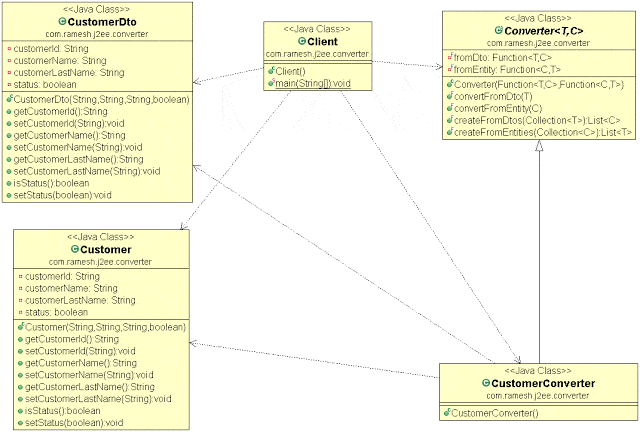您好,登錄后才能下訂單哦!
您好,登錄后才能下訂單哦!
這篇文章主要介紹了Java中轉換器設計模式的作用是什么,億速云小編覺得不錯,現在分享給大家,也給大家做個參考,一起跟隨億速云小編來看看吧!
Java主要應用于:1. web開發;2. Android開發;3. 客戶端開發;4. 網頁開發;5. 企業級應用開發;6. Java大數據開發;7.游戲開發等。
目的
轉換器設計模式的目的是為相應類型之間的雙向轉換提供一種通用的方式,允許類型無需彼此了解的簡潔的實現。此外,轉換器設計模式引入了雙向收集映射,將樣板代碼減少到最小。
源代碼
轉換器設計模式是一種行為設計模式,允許在相應類型(如DTO和邏輯同構類型的域表示)之間進行雙向轉換。此外,該模式還引入了一種在類型之間轉換對象集合的通用方法。
類圖

讓我們根據上面的類圖編寫源代碼。
在本例中,我們將把customerd轉換為customer實體,反之亦然,我們還將在類型之間轉換對象集合。
步驟1:讓我們創建一個通用轉換器。
public abstract class Converter < T, C > {
private final Function < T,
C > fromDto;
private final Function < C,
T > fromEntity;
/**
* @param fromDto
* Function that converts given dto entity into the domain
* entity.
* @param fromEntity
* Function that converts given domain entity into the dto
* entity.
*/
public Converter(final Function < T, C > fromDto, final Function < C, T > fromEntity) {
this.fromDto = fromDto;
this.fromEntity = fromEntity;
}
/**
* @param customerDto
* DTO entity
* @return The domain representation - the result of the converting function
* application on dto entity.
*/
public final C convertFromDto(final T customerDto) {
return fromDto.apply(customerDto);
}
/**
* @param customer
* domain entity
* @return The DTO representation - the result of the converting function
* application on domain entity.
*/
public final T convertFromEntity(final C customer) {
return fromEntity.apply(customer);
}
/**
* @param dtoCustomers
* collection of DTO entities
* @return List of domain representation of provided entities retrieved by
* mapping each of them with the conversion function
*/
public final List < C > createFromDtos(final Collection < T > dtoCustomers) {
return dtoCustomers.stream().map(this::convertFromDto).collect(Collectors.toList());
}
/**
* @param customers
* collection of domain entities
* @return List of domain representation of provided entities retrieved by
* mapping each of them with the conversion function
*/
public final List < T > createFromEntities(final Collection < C > customers) {
return customers.stream().map(this::convertFromEntity).collect(Collectors.toList());
}
}步驟2:讓我們創建一個簡單客戶轉換器的實現。
public class CustomerConverter extends Converter<CustomerDto, Customer> {
public CustomerConverter() {
super(customerDto -> new Customer(customerDto.getCustomerId(), customerDto.getCustomerName(),
customerDto.getCustomerLastName(), customerDto.isStatus()),
customer -> new CustomerDto(customer.getCustomerId(), customer.getCustomerName(),
customer.getCustomerLastName(), customer.isStatus()));
}
}步驟3: 創建customerdto類。
public class CustomerDto {
private String customerId;
private String customerName;
private String customerLastName;
private boolean status;
public CustomerDto(String customerId, String customerName, String customerLastName, boolean status) {
super();
this.customerId = customerId;
this.customerName = customerName;
this.customerLastName = customerLastName;
this.status = status;
}
public String getCustomerId() {
return customerId;
}
public void setCustomerId(String customerId) {
this.customerId = customerId;
}
public String getCustomerName() {
return customerName;
}
public void setCustomerName(String customerName) {
this.customerName = customerName;
}
public String getCustomerLastName() {
return customerLastName;
}
public void setCustomerLastName(String customerLastName) {
this.customerLastName = customerLastName;
}
public boolean isStatus() {
return status;
}
public void setStatus(boolean status) {
this.status = status;
}
}步驟4: 創建Customer實體類。
public class Customer {
private String customerId;
private String customerName;
private String customerLastName;
private boolean status;
public Customer(String customerId, String customerName, String customerLastName, boolean status) {
super();
this.customerId = customerId;
this.customerName = customerName;
this.customerLastName = customerLastName;
this.status = status;
}
public String getCustomerId() {
return customerId;
}
public void setCustomerId(String customerId) {
this.customerId = customerId;
}
public String getCustomerName() {
return customerName;
}
public void setCustomerName(String customerName) {
this.customerName = customerName;
}
public String getCustomerLastName() {
return customerLastName;
}
public void setCustomerLastName(String customerLastName) {
this.customerLastName = customerLastName;
}
public boolean isStatus() {
return status;
}
public void setStatus(boolean status) {
this.status = status;
}
}步驟5: 現在,讓我們通過創建Client類來測試這個模式。
public class Client {
/**
* Program entry point
*
* @param args command line args
*/
public static void main(String[] args) {
Converter < CustomerDto, Customer > CustomerConverter = new CustomerConverter();
CustomerDto dtoCustomer = new CustomerDto("100", "Ramesh", "Fadatare", true);
Customer Customer = CustomerConverter.convertFromDto(dtoCustomer);
System.out.println("Entity converted from DTO:" + Customer);
List < Customer > customers = new ArrayList < > ();
customers.add(new Customer("100", "Ramesh2", "Fadatare", true));
customers.add(new Customer("200", "Ramesh3", "Fadatare", true));
customers.add(new Customer("300", "Ramesh4", "Fadatare", true));
customers.forEach(System.out::println);
customers.forEach((customer) - > System.out.println(customer.getCustomerId()));
System.out.println("DTO entities converted from domain:");
List < CustomerDto > dtoEntities = CustomerConverter.createFromEntities(customers);
dtoEntities.forEach(System.out::println);
dtoEntities.forEach((customer) - > System.out.println(customer.getCustomerId()));
}
}輸出:
Entity converted from DTO:com.ramesh.j2ee.converter.Customer@87aac27
com.ramesh.j2ee.converter.Customer@1b28cdfa
com.ramesh.j2ee.converter.Customer@eed1f14
com.ramesh.j2ee.converter.Customer@7229724f
100
200
300
DTO entities converted from domain:
com.ramesh.j2ee.converter.CustomerDto@4dd8dc3
com.ramesh.j2ee.converter.CustomerDto@6d03e736
com.ramesh.j2ee.converter.CustomerDto@568db2f2
100
200
300
適用性
在以下情況下 使用轉換器模式:
當您擁有邏輯上與其他類型相對應的類型時,您需要在它們之間轉換實體
如果要根據上下文提供不同類型的轉換方式
每當您引入DTO(數據傳輸對象)時,您可能需要將其轉換為域等效。
以上就是億速云小編為大家收集整理的Java中轉換器設計模式的作用是什么,如何覺得億速云網站的內容還不錯,歡迎將億速云網站推薦給身邊好友。
免責聲明:本站發布的內容(圖片、視頻和文字)以原創、轉載和分享為主,文章觀點不代表本網站立場,如果涉及侵權請聯系站長郵箱:is@yisu.com進行舉報,并提供相關證據,一經查實,將立刻刪除涉嫌侵權內容。